Common Mistakes When Choosing Wall Art
When looking at inspiration for wall art online, it’s easy to feel like the choice of art doesn’t matter, and most examples online look great because they’re in an expensive home! But the truth is, if you’re smart about the art pieces you choose to hang, you can make an interior look more incredible than you’d guess. No matter what your home décor looks like, putting some thought into choosing wall art can elevate your space, and transform your interior into something spectacular.Below, we’re going to cover some of the common mistakes you should avoid when choosing art to hang on your wall, so you can get the most out of your home!
The Wrong Art for the Wrong Room
Step one is to make sure that a piece of art matches the room it’s in. A lot of the time, people will choose art pieces that look good online or in a store, but don’t match the room they’re being purchased for.Professional interior designers or decorators usually approach this by first focusing on the function of a room. By understanding what each room is for, you get a better sense of the atmosphere you want to create with certain pieces of art. Sometimes this can require some experimentation, but there are some rules of thumb you can use as a starting point. For instance, a lounge is more likely to have a piece that’s colourful and dramatic than the bathroom, where it’s generally preferable to hang more relaxing or straightforward pieces.
Misusing Wall Space
One of the easiest mistakes to make when hanging art is underusing or overusing the space you have available to you. One piece hanging alone in the middle of a large wall will feel odd, as will many pieces covering a wall completely. You always want a bit of open space to let the pieces breathe, but too much can be distracting.This can depend on personal style; some people go for a very cluttered look on purpose, and this can work occasionally! But for most people’s homes a balance is preferable.
Generally speaking, more open space on a wall is more soothing. This means that louder, more dynamic pieces of art might look better with nothing around them than a more subdued, tame piece of art, because the emptiness balances out the noise of the piece of art. It often depends on the colours of the art and how they contrast with the colour of the wall. A lot of contrast can make one single piece of art pop, while pieces that are a similar colour to the wall will blend into it if surrounded by nothing but empty space.
Setting the Mood for the Wrong People
This mistake is more common than you might guess! When choosing wall art, homeowners often pick pieces based on the impression they want the space to give to guests and visitors. While this is important, and very much worth factoring into your decisions, it’s a mistake to prioritise this over choosing art that makes a good impression on you! And there’s a simple reason for this; you’re the one who has to look at it the most.This is why you’ll hear people saying it’s important to limit how eye-catching art pieces are in places like the bathroom. While it might seem like a fun idea to throw caution to the wind and put a really arresting piece of art in the bathroom, there’s a real chance that you’ll get sick of looking at it while brushing your teeth every day! So, most decorators opt for calming décor in the bathroom, and save more dramatic pieces for rooms where the owner will spend less time, like a hallway near the front door.
Again, it’s ultimately up to you, but it’s always worth thinking ahead and considering what it’s going to really be like looking at a piece of art every day.














